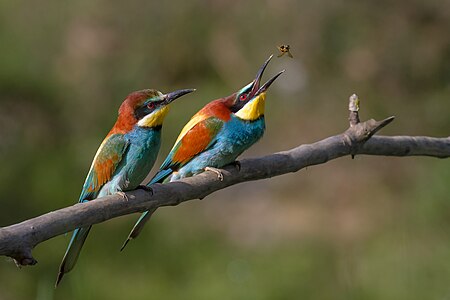Template:Species-2013-03-2
Species of the month[edit]
European Bee-eater[edit]
Some facts on this bird:
Length: 25–29 cm.
Wingspan: 36–40 cm.
Weight: 55 grams.
Diet: Insects, especially bees, wasps and hornets.
Life-span: Up to 6 years.
Range: Breeds in Europe and also in parts of Africa and southern-central Asia. Migrates to spend winter in sub-Saharan Africa. May also overwinter in India.
Habitat: Open landscapes with sheltered valleys that have grassy, marshy terrain with few trees.
Conservation status: Classified as Least Concern (LC) on the IUCN Red List.
First described: By the Sweedish naturatist Linnaeus in 1758.
Eating bees sounds like a painful indulgence, but for Merops apiaster bees are a delicacy. These birds, called "bee-eaters" can devour up to 250 bees daily. Before eating its meal, a European Bee-eater removes the sting by repeatedly hitting the insect on a hard surface. These colorful birds are gregarious, nesting colonially in sandy banks, preferably near river shores at the beginning of May. Each pair excavates a nesting burrow, usually in a vertical earth or sand bank. A nesting tunnel typically measures about a meter long and terminates in a nest chamber. The female lays four to seven eggs, which are incubated for approximately 20 days by both parents. The chicks fledge at about four weeks of age. Some Merops apiaster have "helpers-at-the-nest"; that is, the nesting pair has additional adults helping with feeding the brood. These "helpers" are usually the pair's relatives which failed in their own breeding attempt earlier in the year. The Merops or "bee-eater" genus contains 23 species and belongs the the Meropidae family, which are characterized by richly colored plumage, slender bodies, and usually elongated central tail feathers.
See also: Species of previous months
